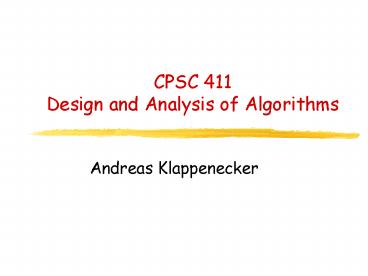CPSC 411 Design and Analysis of Algorithms - PowerPoint PPT Presentation
Title:
CPSC 411 Design and Analysis of Algorithms
Description:
{ Extract 10 digit number p at position i. return p if p is prime. i := i 1 ... Drawback: Needs rational arithmetic with long rationals ... – PowerPoint PPT presentation
Number of Views:29
Avg rating:3.0/5.0
Title: CPSC 411 Design and Analysis of Algorithms
1
CPSC 411 Design and Analysis of Algorithms
- Andreas Klappenecker
2
Motivation
3
Eulers Number
4
Billboard Question
5
Strategy
- Compute the digits of e
- i 0
- while true do
- Extract 10 digit number p at position i
- return p if p is prime
- i i1
6
Computing the Digits of e
- First Approach
- Drawback Needs rational arithmetic with long
rationals - Too much coding unless a library is used.
7
Extracting Digits of e
- We can extract the digits of e in base 10
- by
- d0 floor(e) (equals
2) - e1 10(e-d0)
- d1 floor(e1) (equals
7) - e2 10(e1-d1)
- d2 floor(e2) (equals 1)
- Unfortunately, e is a transcendental number, so
there is no pattern to the generation of the
digits in base 10. - Idea Use a mixed-radix representation that leads
to a more regular pattern of the digits.
8
Mixed Radix Representation
The digits ai are nonnegative integers. The base
of this representation is (1/2,1/3,1/4,). The
representation is called regular if ai is less
than i for i gt1. Number is written as (a0 a1,
a2, a3,)
9
Computing the Digits of e
- Second approach
- In mixed radix representation
- e (21,1,1,1,)
10
Mixed Radix Representations
- In mixed radix representation
- (a0 a1, a2, a3,)
- a0 is the integer part and (0 a1, a2, a3,)
the fractional part. - 10 times the number is (10a0 10a1, 10a2,
10a3,), but the representation is not regular
anymore. - Renormalize the representation to make it regular
again - The algorithm given for base 10 now becomes
feasible this is known as the spigot algorithm.
11
Spigot Algorithm
- define N (1000) / compute N-1 digits of e, by
brainwagon_at_gmail.com / - main( i, j, q )
- int AN
- printf("2.")
- for ( j 0 j lt N j )
- Aj 1
- for ( i 0 i lt N - 2 i )
- q 0
- for ( j N - 1 j gt 0 )
- Aj 10 Aj q
- q Aj / (j 2)
- Aj (j 2)
- j--
- putchar(q 48)
12
Probability to be Prime
- Let pi(x) of primes less than or equal to x.
- Prnumber with lt 10 digits is prime
- pi(99999 99999)/99999 99999
- 0.045 (roughly)
- Thus, we need just a few digits of e to find the
first 10-digit prime number in e.
13
Reinventing the Wheel!
- Since we will likely need just few digits of
Eulers number e, there is no need to reinvent
the wheel. - You can use tabulated numbers or
- you can use tools such as GNU bc
- to obtain a few hundred digits of e.
- Know your resources!
14
How do we check Primality?
- If a number x is not prime, then it has a divisor
d in the range 2lt d lt sqrt(x). - Trial divisions are fast enough here!
- Simply check whether any number d in the range 2
lt d lt 100 000 divides a 10-digit chunk of e.
15
Simple Programhttp//discuss.fogcreek.com/joelons
oftware/default.asp?cmdshowixPost160966ixRepli
es23
- !/bin/sh
- echo "scale1000 e(1)" bc -l \
- perl -0777 -ne '
- s/0-9//g
- for i (0..length(_)-10)
- jsubstr(_,i,10)
- j 0
- print "i\tj\n" if is_p(j)
- sub is_p
- my n shift
- return 0 if n lt 1
- return 1 if n lt 3
- for (2 .. sqrt(n))
- return 0 unless n _
- return 1
16
What was it all about?
- The billboard was an ad paid for by Google. The
website - http//www.7427466391.comcontained another
challenge and then asked people to submit their
resume. - Algorithmic problems are commonly used by
companies when evaluating computer science
candidates.
17
Culture
- Upcoming CSE Distinguished Lectures
- Information Visualization for Knowledge
Discovery,Dr. Ben Shneiderman, University of
Maryland, 410 p.m., Wed, January 21, 2009, Room
124, Bright Building - Camera Networks for Security Applications Dr.
Nikolaos Papanikolopoulos, University of
Minnesota, 410 p.m., Mon, January 26, 2009Room
124, Bright Building































